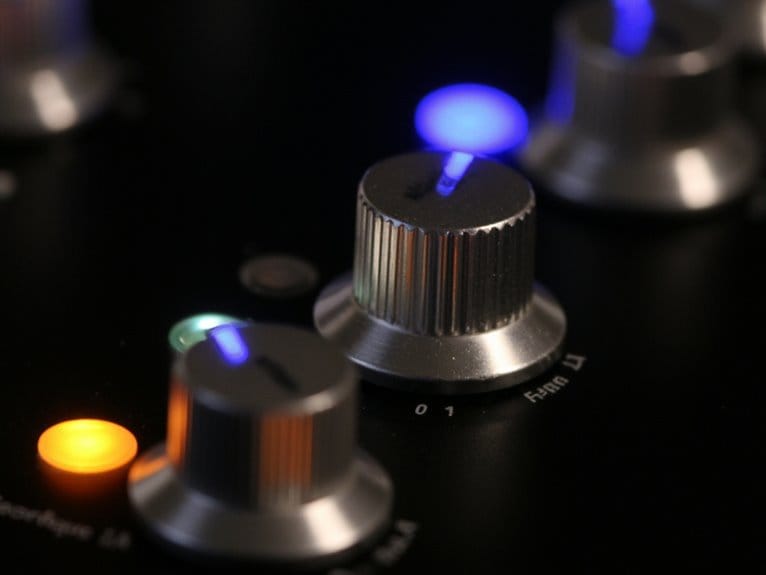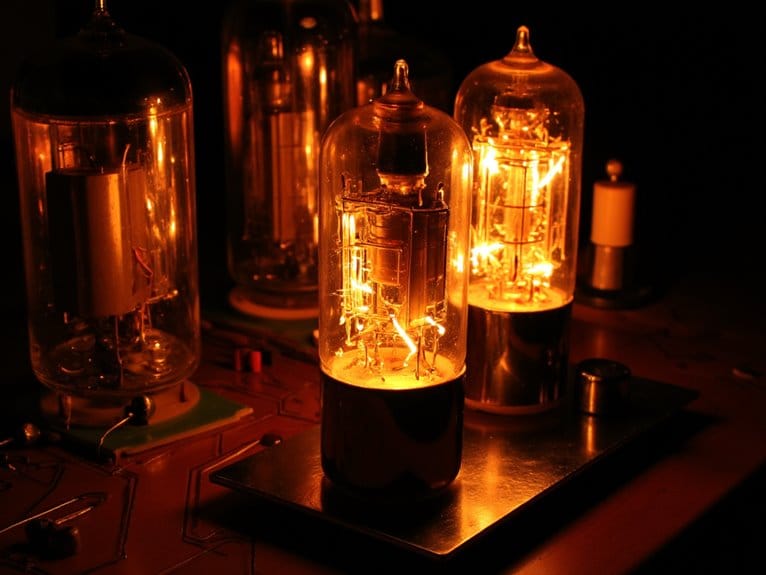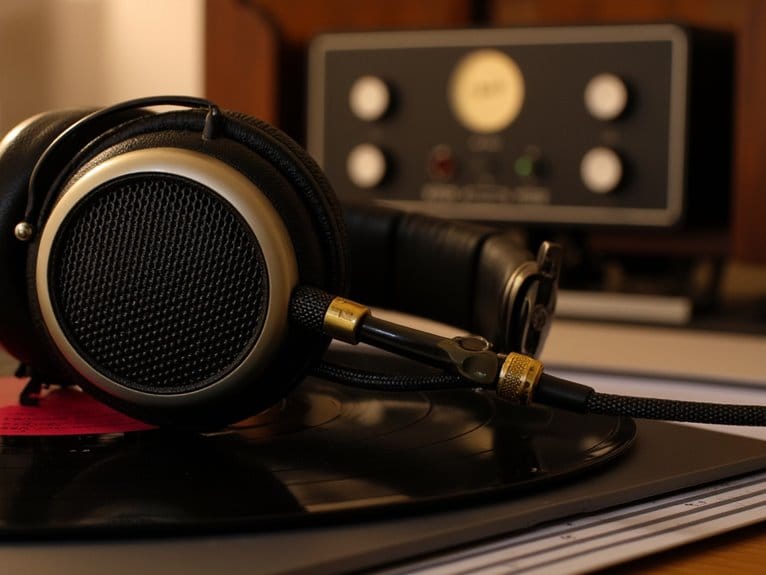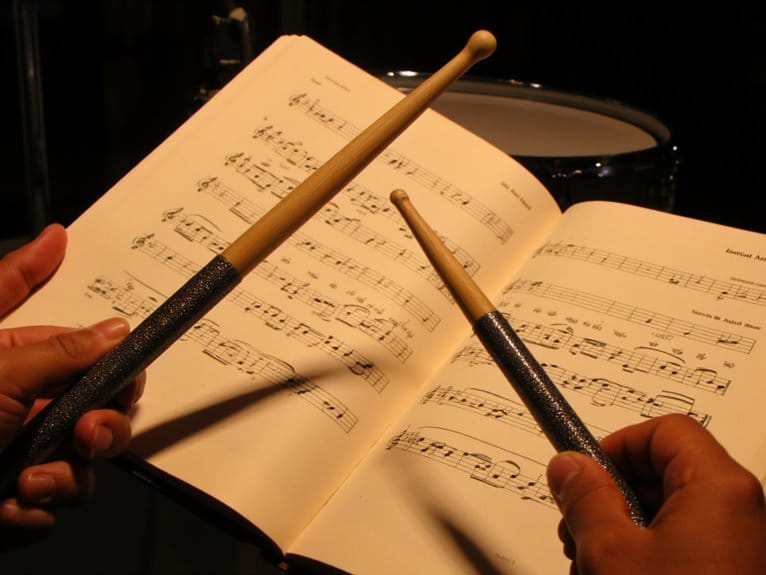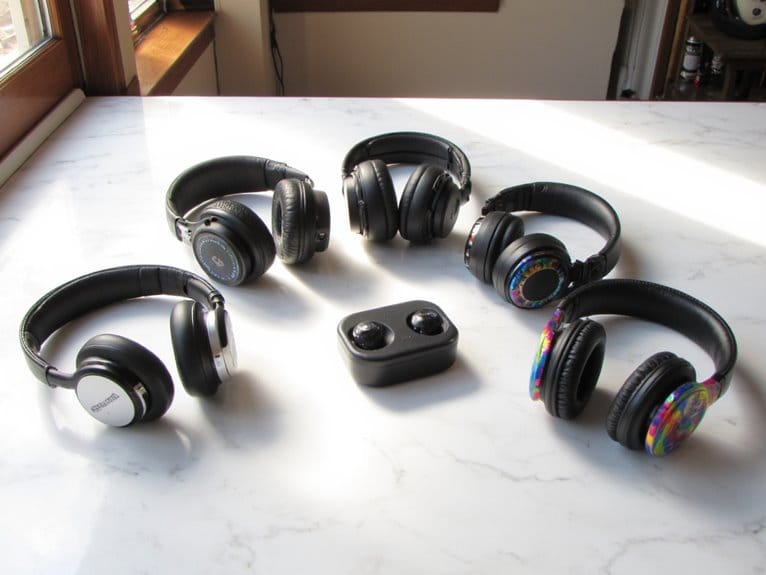Synthesizer Filters: Low-Pass, High-Pass, and Band-Pass Explained
Synthesizer filters work by removing specific frequency ranges to shape your sound’s character and clarity. Low-pass filters preserve frequencies below the cutoff while rolling off higher harmonics, creating the smooth, warm textures you’ll hear in acid house and classic electronic music. High-pass filters eliminate muddy low-end content, brightening your patches and clearing space in dense mixes. Band-pass filters isolate midrange frequencies between 300 Hz and 5 kHz, perfect for telephone-like effects or highlighting specific harmonic regions. Understanding how filter slopes, resonance settings, and classic designs like Moog’s transistor ladder influence your sonic palette will transform your approach to sound design.
We are supported by our audience. When you purchase through links on our site, we may earn an affiliate commission, at no extra cost for you. Learn more.
Notable Insights
- Low-pass filters preserve frequencies below the cutoff while rolling off higher frequencies, creating smooth, creamy textures popular in electronic music.
- High-pass filters remove low-frequency content to eliminate muddiness and create brighter, more articulate sounds in dense musical arrangements.
- Band-pass filters isolate specific frequency ranges, typically 300 Hz to 5 kHz, where most instrument fundamentals reside for enhanced clarity.
- Filter slope characteristics, measured in decibels per octave, determine how aggressively frequencies are cut, affecting harmonic content preservation.
- Modern multi-mode filters allow instant switching between filter types and continuous blending for versatile sound shaping capabilities.
Understanding Low-Pass Filters and Their Warm Character
When you’re diving into the world of synthesizer filters, there’s no better place to start than with the low-pass filter—arguably the most fundamental and widely-used filter type in electronic music production.
The low pass character emerges from its ability to preserve frequencies below the cutoff while creating a gentle frequency roll off above it, resulting in that coveted tonal smoothness electronic musicians chase. Through controlled filter resonance near the cutoff point, you’ll achieve harmonic emphasis that adds musical richness without harsh edges.
This envelope shaping capability allows for dynamic warmth preservation, where fundamental frequencies remain intact while higher harmonics gradually fade, creating the thick, creamy textures that define classic synthesizer sounds from vintage instruments to modern digital recreations. Just as with capturing these rich synthesizer tones, achieving professional recording quality often requires an audio interface that can faithfully reproduce the nuanced frequency content of your filtered sounds. Different filter types like Butterworth, Chebyshev, and Bessel each contribute unique characteristics to this tonal shaping process, affecting both the smoothness of the frequency response and the steepness of the roll-off. When monitoring these filtered synthesizer sounds during production, studio headphones become essential for accurately hearing the subtle frequency changes and ensuring your low-pass filtering achieves the desired warmth without losing critical musical details. Modern polyphonic synthesizers with analog filters continue to deliver this warm character, demonstrating how traditional analog circuitry maintains its relevance in contemporary sound design. The low-pass filter became particularly iconic in Acid House genres, where the Roland TB-303’s distinctive filtering created the signature squelchy bass sounds that defined an entire musical movement.
High-Pass Filters for Cleaning and Brightening Your Sound
While low-pass filters shape your sound by emphasizing warmth and body, high-pass filters work in the opposite direction, cutting away the low-frequency content that can make your synthesizer patches sound muddy, undefined, or cluttered in a mix.
You’ll find these filters particularly useful when you need to create brighter, more articulate textures that cut through dense arrangements, as they effectively remove the rumble and fundamental frequencies that often compete with bass instruments or kick drums. When working with synthesizers, it’s essential to adjust the corner frequency appropriately for each patch rather than using the same filter setting across different sounds.
I’ve discovered that high-pass filtering isn’t just about cleaning up your sound—it’s also a powerful creative tool for crafting everything from ethereal pads that float above your mix to aggressive leads that slice through the heaviest productions.
Removing Muddy Low Frequencies
Though I’ve spent countless hours wrestling with muddy mixes that sound like they’re playing underwater, I’ve learned that high-pass filters are one of the most effective weapons in your sonic arsenal for cutting through the haze.
Mud frequency removal becomes surprisingly straightforward when you understand that frequencies below 80-120 Hz often contribute nothing but unwanted rumble to synthesizer patches, while bass clarity enhancement emerges naturally as you carve away competing low-end content.
Consider these essential applications for eliminating muddy frequencies:
- Remove subsonic noise artifacts that eat headroom without adding musical value
- Clear space for dedicated bass instruments by filtering pad sounds above 100 Hz
- Prevent low-frequency buildup that causes speaker distortion and listening fatigue
- Improve mix translation across different playback systems and environments
When monitoring your filtered synthesizer sounds, ensure your keyboard amplifier provides adequate power output for your venue, as insufficient wattage can mask the clarity improvements you’ve achieved through proper high-pass filtering.
Creating Brighter Sound Textures
High-pass filters become your secret weapon for sculpting brighter, more defined sound textures, working in reverse of their low-pass counterparts by allowing frequencies above your chosen cutoff point to pass through while systematically removing the lower frequencies that can cloud your mix.
When you’re brightening textures, you’ll discover how these filters create space in your frequency spectrum, eliminating muddy low-end content that competes with your lead elements.
The resonance control adds another dimension to your sound design arsenal, boosting frequencies around the cutoff point to enhance tonal clarity and harmonic emphasis.
I’ve found that modulating the cutoff frequency dynamically with envelopes or LFOs creates evolving brightness that transforms static patches into living, breathing textures. Similar to guitarists who rely on true bypass switching to maintain signal integrity when effects are disengaged, preserving the purity of your filtered frequencies ensures optimal sonic clarity.
Many modern multi-effects pedals offer built-in high-pass filtering capabilities alongside their extensive effect collections, allowing guitarists to achieve similar frequency sculpting results in their signal chain.
Just as musicians consider metal construction crucial for pedal durability during heavy performance use, selecting synthesizer filters with robust build quality ensures consistent frequency response under demanding studio and live conditions.
Band-Pass Filters: Focusing on the Sweet Spot
When you’re crafting synthesized sounds, band-pass filters become your precision tool for carving out specific frequency ranges, allowing you to isolate the midrange frequencies where most instruments find their fundamental character and harmonic richness.
I’ve found that these filters excel at dynamic spectral modulation, where you can sweep through different frequency bands in real-time, creating those classic analog synth sounds that seem to breathe and evolve as they play.
You’ll discover that band-pass filtering transforms ordinary waveforms into focused, telephone-like tones or warm, vowel-shaped sounds that cut through dense mixes with surgical precision.
Midrange Frequency Selection
Between the thunderous lows and sparkling highs of your mix lies what I’d argue is the most essential territory in music production: the midrange frequencies, typically spanning 300 Hz to 5 kHz, where vocals cut through, snares crack with authority, and synth leads claim their sonic real estate.
When you’re working with band-pass filters, strategic midrange selection prevents your mix from becoming a muddy mess while maintaining proper frequency balance. A targeted midrange boost can transform a buried vocal into the star of your track, carving distinct spectral space for each element.
Consider these key benefits of precise midrange filtering:
- Eliminates frequency masking between competing instruments
- Enhances vocal clarity and presence without affecting bass response
- Creates defined sonic niches for layered synthesizers
- Preserves high-frequency airiness while focusing attention
Just as guitar amplifiers utilize dual channels to separate clean and driven tones for maximum clarity, effective band-pass filtering creates distinct frequency lanes that prevent sonic competition in your mix. Professional recording setups often employ 24-bit resolution to capture the full dynamic range of these crucial midrange frequencies, ensuring your filtered elements retain their musical impact throughout the production process.
Modern MIDI controllers with velocity-sensitive keys allow real-time manipulation of band-pass filter parameters, enabling dynamic midrange sculpting during live performance and studio recording sessions.
Dynamic Spectral Modulation
While static filters certainly have their place in sound design, I’ve found that dynamic spectral modulation with band-pass filters opens up an entirely different universe of sonic possibilities, one where your synthesized sounds can breathe, evolve, and maintain listener interest through constantly shifting frequency emphasis.
When you employ dynamic modulation techniques like envelope-controlled sweeps or LFO-driven parameter changes, your band-pass filter becomes a living, breathing element that highlights different harmonic regions over time.
I particularly enjoy using spectral layering techniques with multiple band-pass filters running in parallel, each targeting different frequency ranges while their parameters dance independently.
This approach creates formant-like movements reminiscent of vocal qualities, transforming static drones into expressive, organic-sounding textures.
Filter Slopes, Resonance, and Self-Oscillation
Most synthesizer enthusiasts eventually discover that understanding filter slopes, resonance, and self-oscillation opens up a world of sonic possibilities that can transform bland oscillator waveforms into expressive, dynamic sounds.
Filter slope effects determine how dramatically frequencies beyond your cutoff point get attenuated, measured in decibels per octave. I’ve found that gentler slopes like 12 dB/octave preserve harmonic content for warmer tones, while steeper 24 dB/octave settings create more aggressive cuts.
Resonance control becomes your secret weapon for adding character, boosting frequencies near the cutoff for that classic synthesizer sweep sound.
Here’s what you’ll encounter:
- 6-12 dB/octave: Smooth, gradual filtering
- 24 dB/octave: Sharp, dramatic frequency removal
- High resonance: Distinctive ringing and whistling effects
- Self-oscillation: Filter generates pure sine wave tones
Classic Filter Designs That Shaped Electronic Music
The evolution of synthesizer filters reads like a timeline of electronic music’s most defining moments, from the warm analog circuits that shaped the sounds of the 1970s to the digital innovations that revolutionized production in the following decades.
You’ll find that classic filter innovations trace back to Harold Bode’s 1937 Warbo Formant Orgel, which introduced envelope-shaped filtering that influenced generations of synthesizer design.
The modular synthesis evolution truly took off with Moog’s transistor ladder filter, delivering that unmistakable warm resonance you hear across countless records.
The legendary Moog ladder filter became the gold standard, creating that signature warm analog resonance that defined an entire era of music.
ARP’s unique slope characteristics expanded your sonic palette, while EMS VCS3’s voltage-controlled filters created the distinctive textures defining progressive rock.
Later, E-MU’s Z-Plane morphing filters revolutionized digital filtering, offering dynamic interpolation between filter types.
Modern Multi-Mode Filters and Advanced Configurations
As synthesizer technology matured beyond those early pioneering designs, manufacturers began developing multi-mode filters that could switch between different filter types within a single circuit, fundamentally changing how we approach sound design.
These innovative filters employ pole mixing techniques, where individual filter stages are combined with variable polarity to create different responses.
You’ll find this multi-mode versatility particularly evident in classic instruments like the ARP SEM, which offered seamless switching between low-pass, high-pass, band-pass, and notch modes.
Modern multi-mode filters provide several key advantages:
- Instant switching between filter types without circuit changes
- Continuous blending of multiple modes simultaneously
- Digital control integration for precise parameter automation
- Hybrid analog-digital architectures combining warmth with stability
Contemporary budget-friendly synthesizers like the Behringer 2600 demonstrate how multimode filter capabilities have become accessible to producers working within tight financial constraints. These affordable instruments maintain professional sound quality while offering the versatility that was once exclusive to high-end equipment.
Much like how tube amplifiers provide warm harmonic characteristics preferred by audio professionals, certain filter implementations emphasize organic tonal qualities over clinical precision.
Frequently Asked Questions
Can I Use Multiple Filter Types Simultaneously on the Same Sound?
You can absolutely use multiple filter types simultaneously through filter layering techniques. Many synths offer parallel routing, dual filter modes, or multimode filters that blend different types, creating rich simultaneous filtering effects on your sound.
Why Do Some Filters Sound Muddy While Others Sound Clean?
Filter resonance creates frequency masking by boosting specific ranges, causing muddy buildup. You’ll hear cleaner results when resonance stays moderate and doesn’t emphasize overlapping frequencies that compete with other mix elements.
On a final note
You’ve now got the essential knowledge to shape your synthesizer’s voice through filtering, whether you’re rolling off harsh highs with a low-pass, cleaning up muddy bass with a high-pass, or isolating specific frequency ranges with a band-pass. Don’t be afraid to push that resonance knob and experiment with self-oscillation—these tools will transform your patches from basic waveforms into expressive, dynamic sounds that cut through any mix.

